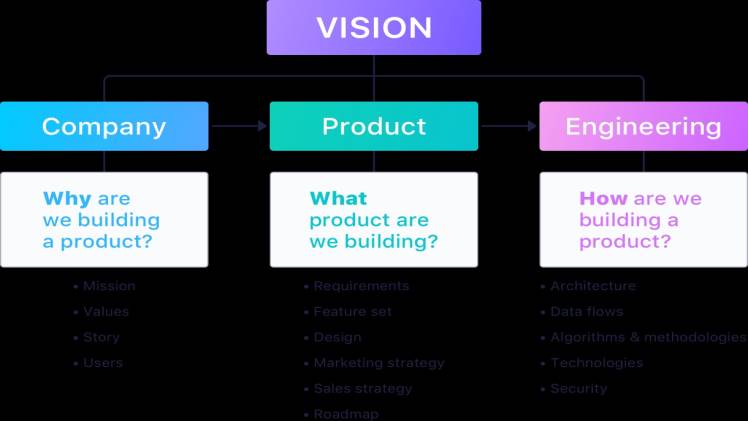Cut Through Chaos: Product Planning Tools to Help Your Team Align on Product Vision

Product marketers are acutely aware of the importance of ensuring that their product vision, strategy, and roadmap perfectly align with their organization’s overarching business objectives.
This alignment is a pivotal factor in achieving success. However, the challenge lies in ensuring that everyone across the organizational spectrum – from top-level executives to dedicated developers – is on the same page and actively working toward the same outcomes.
To tackle this challenge, product marketers turn to a valuable arsenal of product planning software, which are the linchpin for seamless communication, effective collaboration, and comprehensive progress tracking throughout the product life cycle.
This article delves into the world of these product planning tools, uncovering the best options available for harmonizing business goals and strategies while ultimately delivering exceptional value to customers and stakeholders.
What is Product Planning?
Before we dive into product planning tools, it’s imperative to understand what product planning entails. Product planning is meticulously strategizing and outlining how a product will evolve and meet its intended objectives. It encompasses defining the product’s vision, specifying the strategic approach to achieving it, and laying out a detailed roadmap for execution.
At its core, product planning is about answering vital questions, such as:
- What are the business goals that the product aims to fulfill?
- Who is the target audience?
- What are the key features and functionalities that the product should possess?
- How does this product fit into the broader strategy of the organization?
Product planning serves as the compass that guides the product development journey, ensuring that every step aligns with the bigger picture, ultimately leading to a product that resonates with the market and fulfills organizational objectives.
What are Product Planning Tools?
Product planning tools are the digital scaffolds that help product marketers, managers, and their teams bring their product planning process to life. These tools streamline the planning process, making it more accessible, efficient, and transparent. They are centralized platforms where stakeholders can collaborate, share insights, and track progress.
In essence, these tools are multifaceted. They assist in:
- Communication: Facilitating clear and transparent communication among cross-functional teams, ensuring everyone is aware of the latest developments and changes in the product plan.
- Collaboration: Enabling different teams to work harmoniously, sharing their unique perspectives and knowledge to create a comprehensive product strategy.
- Progress Tracking: Offering the ability to monitor the product’s progress throughout its lifecycle, ensuring that it stays on course and remains aligned with the original plan.
- Documentation: Providing a central repository for all product-related documents, from vision statements to feature requirements, makes accessing critical information easy.
What Features to Look for While Picking Your Product Planning Tools?
Choosing the right product planning tool is a critical decision that can significantly impact your product’s success. To ensure you make an informed choice, it’s essential to consider several key features and factors. Here’s a breakdown of what to look for:
- Ease of Use: The tool should be user-friendly and accessible for all team members to adopt. A steep learning curve can hinder collaboration and progress.
- Customization: The ability to tailor the tool to your specific needs is crucial. A one-size-fits-all approach rarely works in the diverse landscape of product planning.
- Integration: Compatibility with your team’s tools and platforms, such as project management software or customer relationship management (CRM) systems.
- Collaboration Features: Robust collaboration features like comments, mentions, and sharing options foster a sense of teamwork and effective communication.
- Visualization: Tools that offer visual representations like roadmaps, timelines, and charts can make complex data more understandable and actionable.
- Accessibility: Ensure the tool is accessible across devices and platforms, making it easy for remote teams to collaborate seamlessly.
- Security: Protecting sensitive product information is vital. Look for tools with top notch security features and data encryption.
- Analytics and Reporting: Tracking and analyzing key performance indicators (KPIs) is crucial for data-driven decision-making.
- Scalability: A tool should grow with your organization and accommodate evolving product planning needs.
- Customer Support: Also look at the quality and availability of customer support, as you may encounter issues that require assistance.
Top 7 Product Planning Tools
With a thorough understanding of product planning and the essential features to consider, let’s explore the top seven product planning tools that are making waves in the market:
Chisel Labs
Key Features:
- Roadmaps like Treeview, Release View, Kanban Board and Timeline View.
- Prioritization Drivers
- User-friendly interface.
- Collaboration features for cross-functional teams.
- Integration capabilities.
- Real-time progress tracking and visualizations.
Chisel Labs offers a comprehensive product management tool for product planning that caters to the needs of seasoned professionals and field newcomers. Its user-friendly interface makes it a great choice for various product planning scenarios.
Portfoleon
Key Features:
- Visual roadmap creation.
- Integration with popular project management tools.
- Resource allocation and tracking.
- Detailed analytics for performance evaluation.
Portfoleon is a valuable tool for product planners prioritizing visual roadmaps and resource management. It integrates seamlessly with popular project management software, making it an excellent choice for teams needing a unified platform for product planning and execution.
Roadmunk
Key Features:
- Drag-and-drop roadmap builder.
- Scenario planning for different product development pathways.
- Collaboration and feedback collection.
- Integration with various project management and analytics tools.
Roadmunk provides an intuitive roadmap-building experience, making it easy for teams to plan different product development scenarios. Its integration options expand its functionality, making it a robust choice for holistic product planning.
monday.com
Key Features:
- Customizable workspaces.
- Workflow automation.
- Collaboration boards.
- Integration with numerous third-party tools.
Monday.com is an all-encompassing work operating system that offers a high degree of flexibility in adapting to various workflows, including product planning. Its customizable workspaces and integration options are valuable assets for teams looking to create a tailored product planning environment.
PivotalTracker
Key Features:
- Agile project management.
- Real-time collaboration.
- Customizable story workflows.
- Integration with development and testing tools.
PivotalTracker is a specialized tool for product planning within an Agile framework. It excels in facilitating real-time collaboration and customizing story workflows, making it an ideal choice for teams practicing Agile development.
SharpCloud
Key Features:
- Dynamic visual storytelling.
- Integration with popular project management tools.
- Scenario modeling and planning.
- Customizable templates for different industries.
SharpCloud stands out with its dynamic visual storytelling capabilities, allowing teams to create engaging presentations and interactive visualizations. Its integration options and scenario modeling tools make it a compelling choice for organizations looking to convey their product plans engagingly and comprehensively.
Jira
Key Features:
- Robust issue and project tracking.
- Integration with development and testing tools.
- Advanced reporting and analytics.
- Customizable workflows.
Jira, developed by Atlassian, is renowned for its issue and project-tracking capabilities. While primarily known as a software development tool, it can get adapted for effective product planning. Its extensive integration options and customizable workflows offer a robust solution for organizations with intricate planning needs.
Conclusion
In product planning, success hinges on harmonizing your product’s vision, strategy, and roadmap with your business goals and objectives. Product planning tools serve as the vital bridge between your vision and the reality of a successful product. The tools mentioned in this article are just a glimpse of the diverse landscape of options available.
Selecting the right product planning tool should be well-informed, considering factors like ease of use, integration, collaboration, and scalability. Each of the top seven tools mentioned has its unique strengths, catering to the varied needs of different teams and organizations.
Ultimately, the key is to choose a tool that empowers your team, aligns with your product planning process, and ultimately paves the way for delivering value to your customers and stakeholders. By doing so, you can ensure that your product journey is successful and rewarding for everyone involved.




